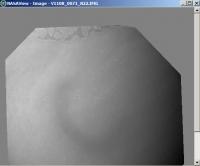Printable Version of Topic
Click here to view this topic in its original format
Unmanned Spaceflight.com _ Venus _ What does this odd pattern in Venus clouds mean?
Posted by: ncc1701d Jul 4 2013, 01:34 AM
I was looking through some venus express images and saw some with this type of pattern in the clouds which seemed atypical for me thinking I thought the clouds were moving around the planet continously and here they seemed stopped. Kind of like looking like when oil and water dont mix. Of course I know that stuff is not on venus but the odd pattern surprised me. I have seen them on enough images now to know its not a camera issue
What is the theory for this behavior? Picture is attached I believe. I am refering to pattern at the top of the image.
thank you.
Posted by: nprev Jul 4 2013, 03:55 AM
That doesn't look real to me; looks like a artifact of some sort. Is this a raw?
Posted by: djellison Jul 4 2013, 04:07 AM
Source for the file? You're probably looking at a level 1 product that isn't flat/dark field processed.
Posted by: ugordan Jul 4 2013, 06:55 AM
Yeah, that looks like the damage that occured when the detector was accidentally pointed at the sun. Some regions of the detector suffered changes in sensitivity, etc. but they are able to flatfield most of that away in calibrated products.
Posted by: Bjorn Jonsson Jul 4 2013, 11:48 AM
Yes, this is probably due to the sun illuminating the detector. Some contaminant seems to have condensed on lenses or detectors but the exact origin isn't clear. There is also a horizontal dark band in UV images that is the track of the sun's image on the detector in images that have not been flatfielded. This band is not visible here.
The problem with the dark spots and filaments in this image is that they change relatively rapidly so you really need one flatfield image per channel per orbit but this is not always possible (sometimes uniform-looking images near the north polar region are acquired near closest approach and can be used).
Posted by: ncc1701d Jul 5 2013, 07:30 AM
The problem with the dark spots and filaments in this image is that they change relatively rapidly so you really need one flatfield image per channel per orbit but this is not always possible (sometimes uniform-looking images near the north polar region are acquired near closest approach and can be used).
Thanks for the info. That must be the reason. Its Raw file. The file name is at the top of the pic. Everyone is right who responded.
Powered by Invision Power Board (http://www.invisionboard.com)
© Invision Power Services (http://www.invisionpower.com)

